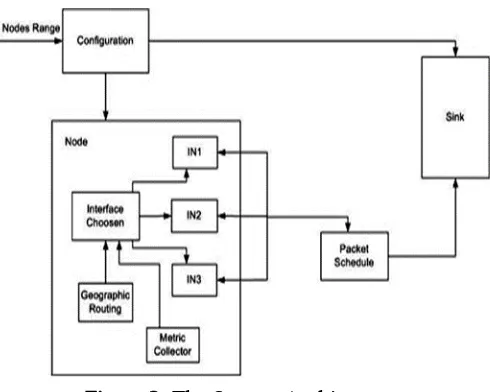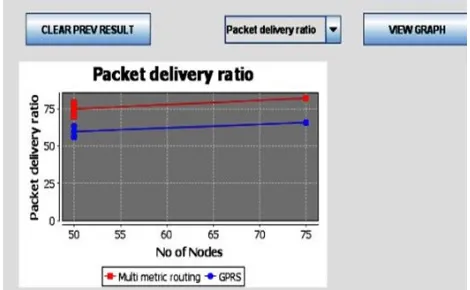CSEIT411807 | Published - 25 April 2018 | March-April-2018 [ (4 ) 1 : 42-46 ]
National Conference on Recent Advances in Computer Science and IT (NCRACIT)
International Journal of Scientific Research in Computer Science, Engineering and Information Technology
© 2018IJSRCSEIT | Volume 4 | Issue 1 | ISSN : 2456-3307
42
Application Dependent Geo Routing Protocol on
Tactical Ad Hoc Networks
Ashwini S K
1, Dr. K. Thippeswamy
21Student, Department of Studies in CSE, Department of PG Studies, VTU Mysuru, Karnataka, India 2Professor & Chairman, Department of Studies in CSE, Department of PG Studies, VTU Mysuru, Karnataka, India
ashwini0621@gmail.com1, thippeswamy_k@hotmail.com2
ABSTRACT
MANETS are provide with multiple radios. The basis of future force communication networks envisioned for use in the war fighting field network-centric applications. In this paper, the propose system is a new geographical routing protocol for a different multi-radio, multi-band in tactical MANET environs. This protocol is designed to use many routing metric with different many radio interfaces, each of which runs on different frequency bandwidths. This protocol gives high quality of service comparing to the existing GPRS technology. For this protocol we are using JProwler simulator.
Keywords: Tactical Ad Hoc Networks, Geographical Routing Protocol, Multi-Metric
I.
INTRODUCTION
A propose system is a new novel multi-metric geographical routing protocol with multi-radio for next generation TMMR. While location-based routing algorithms adopt a single radio, our scheme assumes that each node has multiple interfaces over multiple frequencies, resulting in different transmission ranges. In this new protocol, a node is also assumed to share its own location information with neighboring nodes by exchanging periodic hello messages without control messages. [1]. Problems arise when these existing algorithms are deployed in the multi-interface with different communication range. In this environment, the location routing protocols basically does not support multi-radio environment. Tactical Information Communication Network is one of the fundamental information communication systems, which constitute the information mesh network of NCW [2]. We propose a novel multi-metric geographical routing protocol
with different multi-radio TMMR. The networking structure in tactician information communication network is as shown in the Figure 1.
From the performance point of view, military networks are characterized by very strong requirements of data packet loss and delay compared to commercial networks, because it is more mission critical. Therefore, it is important to provide the appropriate routing path in accordance with tactical application requirement for Quality of Service (QoS). Also, since future tactical wireless networks should be able to coordinate services in dynamic network environments, how to make a selection of optimal interface depending on the type of demanding application is important [3].
scheme assumes that each node has multiple interfaces over multiple frequency bands, resulting in different transmission ranges. In our protocol, a node is also assumed to share its own location information with neighboring nodes by exchanging periodic hello messages without control messages. The main idea behind the proposed scheme is for node to select the most appropriate radio interface and hence routing metric corresponding to its on-demand data types [4].
Figure 1. TMMR Networking Structure in Tactican Information Communication Network
II.
SYSTEM DESIGN
A. Fundamental Design Concepts
A set of fundamental design concepts has evolved over the past three decades. Although the degree of interest in each concept has varied over the years, each has stood the test of time. Each provides the software designer with a foundation from which more sophisticated design methods can be applied. The fundamental design concepts provide the necessary framework for getting it right. The fundamental design concepts such as abstraction, refinement, modularity, software architecture, control hierarchy, structural partitioning, data structure, software procedure and information hiding are applied in this project to getting it right as per the specification.
B. System Architecture
System architecture is the conceptual design that defines the structure and behavior of a system. An architecture description is a formal description of a system, organized in a way that supports reasoning
about the structural properties of the system. It defines the system components or building blocks and provides a plan from which products can be procured, and systems developed, that will work together to implement the overall system. The System architecture is shown in Figure 2.
Figure 2. The System Architecture
C. Data Flow Diagram For The System
Data-flow diagram (DFD) is a graphical representation of the "flow" of data through an information system. DFDs can also be used for the visualization of data processing. On a DFD, data items flow from an external data source or an internal data store to an internal data store or an external data sink, via an internal process.
Level 0 Data flow diagram
Figure 3. Level 0 Data Flow Diagram.
Level 1 Data flow diagram
The Level 1 DFD shows how the system is divided into sub-systems, each of which deals with one or more of the data flows to or from an external agent, and which together provide all of the functionality of the system as a whole. It also identifies internal data stores that must be present in order for the system to do its job, and shows the flow of data between the various parts of the system. The Level 0 Data flow diagram is shown in Figure 4.
Figure 4. Level 1 Data flow diagram.
III.
PERFORMANCE
Quality assurance consists of the auditing and reporting functions of management. The goal of quality assurance is to provide management with the data necessary to be informed about product quality, thereby gaining insight and confident that the product quality is meeting its goals. This umbrella activity is applied throughout the engineering process.
Software quality assurance encompasses:
Analysis, design, coding and testing methods and tools
Formal technical reviews that are applied during each software engineering
Mulitiered testing strategy
Control of software documentation and the change made to it.
A procedure to ensure compliance with software development standards.
Measurement and reporting mechanisms.
The software quality assurance is comprised of a variety of tasks associated with seven major activities: Application of technical methods.
Conduct of formal technical reviews Software testing
Enforcement of standards Control of change
Measurement
Record keeping and reporting
IV.EXAMINATION OF OUTCOMES
Following are the interpretation results getting in the simulation process.
A. End to End Delay:
Figure 5. Output of End to End delay
Figure 6. Output - Multi Metric Routing Of End To End Delay
B. Packet Delivery Ratio
It is the ratio of the number of packets received at the destination over the number of packets generated by the sources. As shown in the figure 7 and figure 8, the Ratio of the packet delivery is very high in multi metric while comparing to the GPRS technology. Hence the performance of this multi metric technology is very high comparing to the existing GPRS technology.
Figure 7. Output of Packet Delivery Ratio
Figure 8. Output of multi metric routing of Packet Delivery Ratio
C. Throughput
It is defined as the amount of successful received data measured in Megabyte per second, which reflects network reliability and performance for delivering video streaming. As shown in the figure 9 and figure 10, the throughput is very high in multi metric while comparing to the GPRS technology. Hence the performance of this multi metric technology is very high comparing to the existing GPRS technology.
Figure 9. Output of the Throughput
Figure 10. Output of multi metric routing of Throughput
V.
CONCLUSION
interfaces in the set can be chosen. Simulation preliminary results show that the proposed scheme outperforms than simple GPSR scheme in terms of end-to-end delay, packet delivery ratio and throughput with low overhead.
The End to End delay is less in multi metric while comparing to the GPRS technology. The Ratio of the packet delivery and the throughput are very high in multi metric while comparing to the GPRS technology hence the performance of the multi metric technology is very high and useful when comparing to the existing GPRS technology.
As a future work, we plan to perform extensive simulation to explore the trade-offs made by different metrics in the protocol. Adapting the protocol for energy efficiency and mobility prediction are also our future inquiry.
VI.REFERENCES
[1] J.L. Burbank, P.F. Chimento, B.K. Haberman, W.T. Kasch, Key Challenges of Military Tactical Networking and the Elusive Promise of MANET Technology‖, IEEE Communications Magazine, vol. 44, Issue: 11 , 2006
[2] M. S. Hasan, M. LaMacchia, L. Muzzelo, R. Gunsaulis, ―Designing the joint tactical radio system (JTRS) Handheld, Manpack, and small Form Fit (HMS) Radios for interoperable networking and waveform applications,‖ in Proc. of IEEE MILCOM, 2007 Stations in Tactical Information Communication Networks,‖ in Proc. of IEEE WCNC, 2011
[6] L. Blazevic, L. J. Boudec, S. Giordano, ―A Location-Based Routing Method for Mobile Ad Hoc Networks,‖ IEEE Transactions on Mobile computing, vol. 3, no. 4, pp. 97--110, 2005
[7] A. A. Sakr, A. M. Kozae, M. Elshafae, M. R. Ibraheem, ―Optimizing Network Routing by Deducing a QoS Metric Using Rough Sets,‖
International Journal of Engineering Science and Technology, vol. 2(7), pp. 2101--3110, 2010
[8] Zhongliang Zhao, Denis Ros´ario,Torsten Braun, Eduardo Cerqueira, Hongli Xu, Liusheng Huang, "Topology and Link Quality-aware Geographical Opportunistic Routing in Wireless Ad-hoc Networks", IEEE-2013, pp 1522-1527
[9] Hyochun Ahn, Youn Seo, Jaebeom Kim, Young-Bae Ko1,"Multi-metric Geo-Routing protocol for Tactical Ad Hoc Networks", IEEE-2013, pp 89-94 [10] R. Rajendran,Jan de Jongh, "An Efficient and
Reliable Multi-Hop Geographical Broadcast Protocol in Vehicular Ad-Hoc Networks", ITST-IEEE, 2013, pp 1-7
[11] George Mastorakis, Athina Bourdena, Constandinos X. Mavromoustakis, Evangelos, Pallis, George Kormentzas, "An Energy-efficient Routing Protocol for Adhoc Cognitive Radio Networks", Future Network & MobileSummit 2013, pp 1-10
[12] Yali Wang,y Cedric Westphal,y J.J. Garcia-Luna-Aceves, "Using Geographical Coordinates To Attain Efficient Route Signaling in Ad Hoc Networks", IEEE-2013, pp-1-9
[13] Youngchol Choi and Yong-Kon Lim, "Geographical
AODV protocol for multi-hop maritime
communications", IEEE-2013


